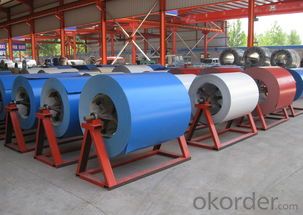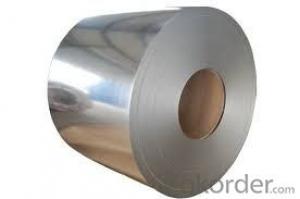Color Hot Rolled Steel Coil /Cold Rolled Steel Coil
- Loading Port:
- Shanghai
- Payment Terms:
- TT OR LC
- Min Order Qty:
- 20 m.t.
- Supply Capability:
- 9000 m.t./month
OKorder Service Pledge
OKorder Financial Service
You Might Also Like
Hot rolled coils/plates
Type: steel coil and steel plates
Material: SS400-Q235-Q345-SPHC
Width:1250mm 1500mm 1800mm 2000mm
HOT-ROLLED COIL/PLATES(Material: SS400-Q235A/B-SPHC) | |||
2.00*1250/1500L | 3.50*1250/1500L | 5.75*1250/1500L | 11.50*1250/1500L |
2.30*1250/1500L | 3.75*1250/1500L | 7.50*1250/1500L | 11.75*1250/1500L |
2.50*1250/1500L | 4.50*1250/1500L | 7.75*1250/1500L | 13.50*1250/1500L |
2.75*1250/1500L | 4.75*1250/1500L | 9.50*1250/1500L | |
3.00*1250/1500L | 5.50*1250/1500L | 9.75*1250/1500L | |
PATTERN-ROLLED COIL/PLATES(Material: Q235A-Q235B) | |||
3.00*1250L | 3.75*1250L | 4.75*1250L | 5.75*1250L |
3.50*1250L | 4.50*1250L | 5.50*1250L | 7.50*1250L |
MIDDEL-PLATE(Material: Q235A/B-Q345A/B) | |||
8*1800/2000L | 16*1800/2000L | 25*1800/2000L | 45*1800/2000L |
10*1800/2000L | 18*1800/2000L | 30*1800/2000L | 50*1800/2000L |
12*1800/2000L | 20*1800/2000L | 35*1800/2000L | |
14*1800/2000L | 221800/2000L | 401800/2000L | |
Name | galvanized steel coil dx52d z gi |
Grade | GB/T-12754: 2006, JIS3302, EN 10142, ASTM A653, JIS G3302, SGCC/SGCH, GB/T2518, European Standard, ASTM A792, JIS G3321, JIS G3317 |
BASE PLATE | Cold rolled steel sheet, hot dipped zinc coated steel sheet hot dipped A-Z coated steel sheet |
EQUIPMENT | Double coating double baking; |
CAPACITY | 5000Mt/week |
SIZE | Thickness 0.18mm—2mm, width 40mm—1250mm |
ZINC COATING | 40g-275g /m2 |
PAINT THICKNESS | Top:20+-5um, back:5-7um |
COIL WGT | 3Mt - 8Mt |
COIL ID | φ508mm,φ610mm |
BASE SHEET | Cold rolled steel sheet, hot dipped zinc coated steel sheet (small, regular or zero spangle), hot dipped A-Z coated steel sheet |
SURFACE PAINT | EP, PE, HDP, SMP, PVDF |
COLOR SERIES | RAL color number series |
Applications of cold rolled steel sheet coil :
1) Automotive bodies: filters, fuel tanks, etc.
2) Construction materials: roofings, welding pipes,
3) Electric and electronic appliances: computer cans, etc.
4) Steel cans: containers, etc.
5) Steel furniture: washing machines, refrigerators, microwaves, etc.
6) Drums
7) Office equipment: printer, recorders, etc.
8) Motors and transformers
Process of cold rolled steel sheet coil :
Pay off reel-double cut shear-welder-notcher-entry accumulator-pre cleaning section-furnace-hot bridle-zinc pot-air knife-after cooler-water quench-dryer- skin pass mill-dryer-tension leveler-dryer-chemical coater-chemical oven-cooler-exit accumulator-oiler-exit shear-tension reel.
Features of cold rolled steel sheet coil :
1) cold rolled steel coils prices is manufactured to have a long durability, strong corrosion resistance and shiny surface.
2) cold rolled steel coils prices features excellent forming properties, paintability, weldability, and is suitable for fabrication by forming, pressing and bending.

Q&A Acceptable payment term and way ?
ANSWER: T/T,L/C, T/T + L/C, D/P
Q&A Do you accept OA payment terms?
ANSWER: Yes, sure, but it normally depending on the order value
Q&A Do you have QC team?
ANSWER: Yeah, sure, our QC team is very important, they will keep the quality control for our products.
- Q:What's the best way to open a 10mm thick steel sheet?
- Sheet steel is produced by hot rolling or cold rolling, with steel plates between 0.2-4mm in thickness. The width of the steel plate is between 500-1400mm. According to different uses, the thin steel plate is rolled with different material billets. The materials are carbon steel, fine carbon steel, alloy structural steel, carbon tool steel, stainless steel, spring steel and electrical silicon steel. They are mainly used in automobile industry, aviation industry, enamel industry, electrical industry, machinery industry and so on. In addition to the direct delivery of rolled steel sheets, there are also kinds of pickling, galvanizing and tinning.
- Q:How do steel sheets compare to other materials like aluminum or plastic?
- Steel sheets offer several advantages over other materials such as aluminum or plastic. Firstly, steel is notably stronger and more durable than both aluminum and plastic. It possesses a higher tensile strength and can withstand significantly greater loads and impacts. As a result, steel sheets are more suitable for applications that demand high strength and structural integrity, like the construction, automotive, and aerospace industries. Secondly, steel exhibits greater resistance to extreme temperatures and fire compared to aluminum or plastic. With a higher melting point, steel sheets are less likely to deform or lose their structural integrity under high temperatures. This characteristic makes them ideal for applications involving exposure to heat or fire, such as industrial furnaces or fire-resistant structures. Moreover, steel sheets offer superior corrosion resistance when compared to aluminum or plastic. Steel can be coated with various protective layers like zinc or paint to prevent rusting and corrosion. Conversely, aluminum is prone to corrosion in specific environments, while plastic may degrade and become brittle over time. Consequently, steel sheets are a more reliable choice in applications where exposure to moisture or corrosive substances is a concern, such as marine environments or chemical processing plants. Lastly, steel sheets are more environmentally friendly than both aluminum and plastic. Steel is a recyclable material that can be reused indefinitely without losing its properties. On the other hand, aluminum recycling requires significantly more energy, and plastic has a known detrimental impact on the environment due to its slow decomposition. Therefore, for those seeking environmentally friendly options, steel sheets, being recyclable and sustainable, are the preferred choice. In conclusion, steel sheets surpass materials like aluminum or plastic in terms of strength, durability, resistance to extreme temperatures and corrosion, as well as being more environmentally friendly. However, the specific choice of material ultimately depends on the application requirements, cost considerations, and other factors.
- Q:Can steel sheets be used for elevator shafts?
- Indeed, elevator shafts can utilize steel sheets. Steel, renowned for its durability, strength, and fire-resistant qualities, finds widespread application in the construction of elevator shafts. Typically, steel sheets are employed to form the walls and floors of these shafts, furnishing them with structural reinforcement and ensuring the safety of the entire elevator system. These sheets can be easily fabricated, allowing for precise tailoring to accommodate the specific dimensions and design prerequisites of the shaft. Moreover, various coatings can be applied to steel sheets to impede corrosion and bolster their longevity. Consequently, steel sheets represent a fitting choice for the construction of elevator shafts, providing a dependable and sturdy solution for vertical transportation systems.
- Q:How do steel sheets perform in terms of scratch resistance?
- Steel sheets generally have good scratch resistance due to their strong and durable nature. They are less susceptible to scratching compared to other materials, making them suitable for various applications where scratching is a concern. However, the scratch resistance may vary depending on the specific type and finish of the steel sheet.
- Q:Can steel sheets be used in the electronics industry?
- Indeed, the electronics industry does make use of steel sheets. Although plastic and aluminum are usually the preferred materials for manufacturing electronic devices, steel sheets can still contribute to the production process. In fact, steel sheets are frequently employed to fabricate structural elements, enclosures, brackets, and various other parts found within electronic devices. They offer robustness, longevity, and safeguard intricate electronic components. Additionally, steel sheets are utilized to shield electronic equipment from electromagnetic interference (EMI). Consequently, steel sheets possess numerous applications in the electronics sector, rendering them a suitable material selection for specific components and enclosures.
- Q:What is the coefficient of friction of steel sheets?
- The coefficient of friction of steel sheets can vary depending on the specific surface conditions and other factors. However, on average, the coefficient of friction of steel sheets is typically around 0.6 to 0.8.
- Q:Are steel sheets suitable for architectural roofing?
- Yes, steel sheets are suitable for architectural roofing. Steel is a highly durable and long-lasting material, making it an excellent choice for architectural roofing applications. Steel sheets offer significant strength, allowing them to withstand harsh weather conditions, including heavy rain, snow, and strong winds. They are also fire-resistant, which adds an extra layer of safety to the building. Moreover, steel sheets are lightweight compared to other roofing materials, making them easier to install and reducing the overall load on the structure. Additionally, steel sheets come in a variety of colors and finishes, allowing architects to achieve the desired aesthetic appearance for the building. Overall, steel sheets offer numerous advantages for architectural roofing, making them a suitable choice for both residential and commercial projects.
- Q:Are steel sheets suitable for food storage applications?
- Steel sheets are indeed suitable for food storage applications. Steel is a highly durable and versatile material that is resistant to corrosion, making it an excellent choice for storing food. Steel sheets provide a hygienic and safe environment for food, as they are non-porous and do not absorb odors or flavors. They also offer protection against contaminants and pests, ensuring the integrity and freshness of the stored food. Additionally, steel sheets are easy to clean and maintain, making them ideal for food storage facilities, restaurants, and any other application where food safety is a priority.
- Q:What are the dimensions of the steel sheets?
- Depending on specific requirements or intended use, the dimensions of the steel sheets may differ. Standard sizes for steel sheets are often found in dimensions like 4 feet by 8 feet or 1 meter by 2 meters. Nonetheless, customizing the dimensions of the sheets is also possible to cater to project needs. To ensure the steel sheets meet the required specifications, it is crucial to specify the desired length, width, and thickness when placing an order.
- Q:Can the steel sheets be used for industrial machinery?
- Yes, steel sheets can be used for industrial machinery. Steel is a popular choice for the construction of industrial machinery due to its high strength, durability, and resistance to wear and tear. Steel sheets can be shaped, cut, and welded to create various components and parts required in industrial machinery. The versatility of steel allows manufacturers to design and fabricate machinery with precise specifications and requirements. Moreover, steel's ability to withstand heavy loads, extreme temperatures, and corrosive environments makes it suitable for use in a wide range of industrial applications.
1. Manufacturer Overview |
|
|---|---|
| Location | |
| Year Established | |
| Annual Output Value | |
| Main Markets | |
| Company Certifications | |
2. Manufacturer Certificates |
|
|---|---|
| a) Certification Name | |
| Range | |
| Reference | |
| Validity Period | |
3. Manufacturer Capability |
|
|---|---|
| a)Trade Capacity | |
| Nearest Port | |
| Export Percentage | |
| No.of Employees in Trade Department | |
| Language Spoken: | |
| b)Factory Information | |
| Factory Size: | |
| No. of Production Lines | |
| Contract Manufacturing | |
| Product Price Range | |
Send your message to us
Color Hot Rolled Steel Coil /Cold Rolled Steel Coil
- Loading Port:
- Shanghai
- Payment Terms:
- TT OR LC
- Min Order Qty:
- 20 m.t.
- Supply Capability:
- 9000 m.t./month
OKorder Service Pledge
OKorder Financial Service
Similar products
New products
Hot products
Hot Searches
Related keywords






























